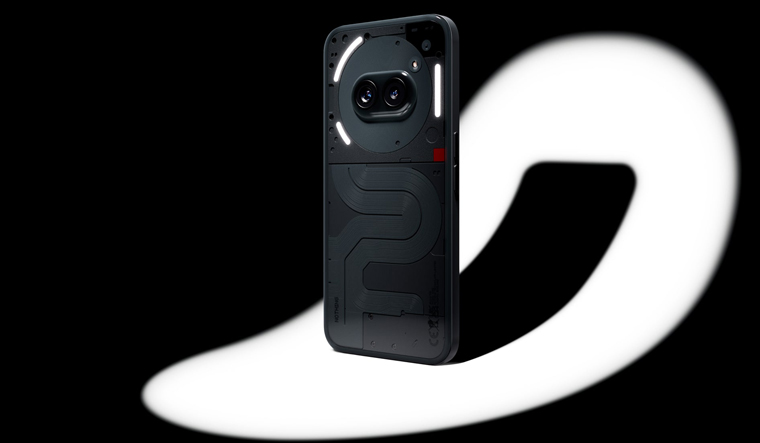Nothing is a relatively new player in the smartphone market, having recently launched its third phone, the Nothing Phone (2a). The company appears to be performing well in the mid-range segment with its unique-looking devices and distinctive names, which set them apart from established brands. Priced at Rs. 23,999 for the base model and Rs. 27,999 for the highest one, the Phone (2a) targets a highly competitive market segment that is currently seeing an influx of 5G devices. Can it be considered a recommendable option? Let's explore further.
The Phone's biggest USP, at first glance, is its transparent back, which houses LEDs. This feature is reminiscent of Nothing's previous two phones, although this time the back is made of plastic and has fewer LEDs, which are only located in the top half. On the back, you can see the screws, coil, a red block, and a few other components. The dual camera setup is positioned near the top and is surrounded by LEDs. The device is available in black and white color options (although there is also a milk color, but it's unclear how it can be obtained). The black variant quickly attracts a lot of smudges and fingerprints, and if this is a concern, it would require frequent cleaning.
Moving to the front, the 6.7-inch display, topped with Corning's Gorilla Glass 5, is surrounded by thin and symmetrical bezels. The front-facing camera is located at the top-middle, underneath which the ear-speaker grille is positioned, appearing as a bit of a blemish at the top. The device weighs 190 grams, has rounded corners, and features matte plastic sides that provide a grippy and comfortable feel, despite not being a compact phone by any means.
The 6.7-inch full HD+ (1084 x 2412) AMOLED display features variable refresh rates ranging from 30 to 120Hz. It is bright and remains usable under direct sunlight, although you may need to increase the brightness if it has not been done already. The display is vibrant, with punchy colors and deep blacks, making it capable of handling high-resolution videos and images effectively. While it can handle HDR content okay-ish in terms of color contrast, don't expect much more.
The phone features a dual camera setup on the back, comprising a 50MP (f/1.88) main camera with OIS and EIS, and a 50MP (f/2.2) ultra-wide camera. The camera performs decently for daylight and portrait shots, but it doesn't quite match the best in its segment, such as Realme and Redmi. It can capture detailed shots with still subjects, but in slightly low lighting, it tends to lose out on details and produce rather grainy shots. However, the ultra-wide camera performed slightly better in handling exposure and dynamic range. The camera app is quick and offers numerous options, which are easily accessible. The front-facing 32MP (f/2.2) camera can capture nice selfie shots with good exposure and is more than capable for video calls.
Running on Nothing OS 2.5.2, based on Android 14 with the February security update, the phone comes with MediaTek’s Dimensity 7200 Pro chipset (up to 2.8Ghz octa-core processor and Mali G68 MC4 GPU) along with 12GB LPDDR4X RAM and 256GB UFS2.2 storage (also comes in 8GB + 128GB or 256GB variants). The phone’s Glyph interface, powered by LEDs on the back, adds a somewhat unique flavor to Nothing devices. You can choose to light up the LEDs for notifications, calls, or adjust the pattern for a particular caller or even a notification from an app, which can be useful when the phone is placed screen-down. Nothing OS itself has almost no third-party apps installed out of the box. It follows a dotted UI pattern for icons, UI elements, including widgets and Settings, which looks nice and clean, but of course, that’s subjective. By default, you have the dark mode enabled, which goes well with the overall aesthetics of the OS. Notably, there’s no Gallery app or even a compass app as part of Nothing OS.
The Nothing OS itself has almost no third-party apps installed out of the box. It follows a dotted UI pattern for icons, UI elements, including widgets and Settings, which looks nice and clean, but of course that’s subjective. By default, you have the dark mode enabled, which goes well with the overall aesthetics of the OS. Notably, there’s no Gallery app or even a compass app part of Nothing OS.
The phone's WiFi, Bluetooth, and call quality were all fine, but it did show some odd orientation behavior with its gyroscope, especially when using Google Maps while the phone is sitting idle. The 5G reception was pretty good and in line with competitors in this price segment, which is nice to see that a new entrant in this budget segment is not compromising on it.
The phone is powered by a 5,000mAh battery unit, which typically lasts about 22-24 hours, rarely requiring a charge during heavy use. The phone supports up to 45-watt charging (no charger and case included in the box) using a compatible PD charger, taking 60-65 minutes to charge from 1% to full.
In summary, Nothing’s new Phone (2a) isn’t a complete home run when it comes to performance and the camera, but it also has a lot of things to like about it – the software experience and customizable OS out of the box, good battery life, and a somewhat unique design, though you might only find Glyph still gimmicky. So, for those who value these things more, this is a considerable option around 25k today.


